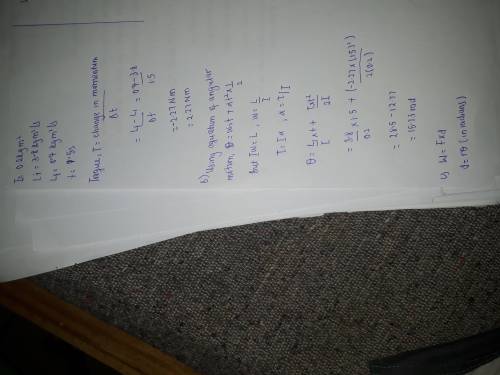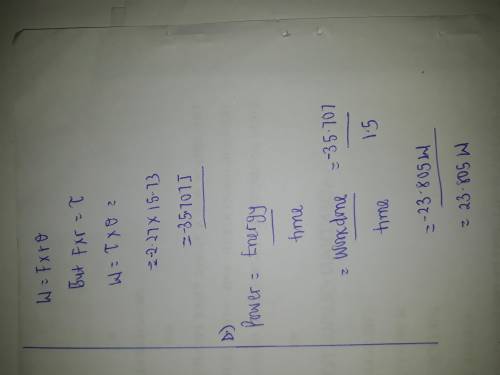
Physics, 13.03.2020 02:21 Halieyrobinson3003
The angular momentum of a flywheel having a rotational inertia of 0.200 kg·m2 about its central axis decreases from 3.80 to 0.400 kg·m2/s in 1.50 s. (a) What is the magnitude of the average torque acting on the flywheel about its central axis during this period? N·m (b) Assuming a uniform angular acceleration, through what angle does the flywheel turn? rad (c) How much work is done on the wheel? J (d) What is the average power of the flywheel? W

Answers: 3


Other questions on the subject: Physics

Physics, 21.06.2019 19:30, nsankey8032
The lights used by mark watley (played by matt damon) during the film the martian seem to be metal halide lamps. metal halide lamps are filled with vaporized mercury and metal-halogen compounds. when an electric current is passed through the lamp, the tube begins to glow a bright white/blue color. if you were to pass this light through a prism to separate the individual light frequencies, you would see a rainbow just as you would if using natural sunlight because of the complexity of the metal halide gas and the vast amount of possible electron transitions. (the study of light in this way is known as spectroscopy and allows astronomers to know exactly what atoms compose distant stars, simply by looking at the light they emit. the spectral lines an atom produces uniquely identifies that atom just like a fingerprint uniquely identifies a person. the momentum equation and energy equation that we have used above can be combined to give the following equation: c = e p where again p is the phonon momentum, e is the photon energy and c is the speed of light. when you divide the photon energy found in #6 by the photon momentum found in #4, do you get the speed of light? (if not, check your work for questions #4 through #6). yes no
Answers: 2


Physics, 22.06.2019 08:30, ljwatts25
Pl asaaap ! match the term to the correct description. a type of wave that transfers energy where the particles in the medium move perpendicular to the direction in which the energy is traveling. a type of wave that transfers energy where the particles in the medium move parallel to the direction in which the energy is traveling. movement that is back and forth, like an equal sign = a type of wave that transfers energy where the particles in the medium move in a circle motion while the energy travels left or right. movement that is like a t transfers energy from one location to another 1. wave 2. parallel movement 3. perpendicular movement 4. transverse wave 5. longitudinal wave 6. surface wave
Answers: 1

Physics, 22.06.2019 14:00, mariahgriego4126
Why is rain likely when warm, moisture-laden air meets cold air? a) the lighter warm air will rise and cool down, causing condensation and rain. b) the cold air moves faster and pushes the warm air away, causing condensation and rain. c) the moisture in the warm air condenses on contact with the cold air, causing rain to fall. d) the cold air mixes with the warm air, reducing its temperature causing moisture to condense.
Answers: 1
You know the right answer?
The angular momentum of a flywheel having a rotational inertia of 0.200 kg·m2 about its central axis...
Questions in other subjects:

Mathematics, 20.08.2019 10:10


Mathematics, 20.08.2019 10:10




English, 20.08.2019 10:10

Physics, 20.08.2019 10:10

Mathematics, 20.08.2019 10:10

Mathematics, 20.08.2019 10:10





